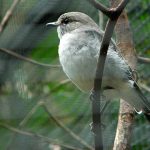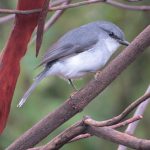JACKY WINTER
The Jacky Winter is a compact bird measuring about 13 to 15 cm in length. It has a plump body, short tail, and a round head. The upperparts are predominantly grey, while the underparts are pale to white. The male and female have similar plumage, characterized by a distinct black “V” marking on the forehead, white eyebrows, and a small white patch at the base of the tail.
It is found throughout mainland Australia, except for the far north and the southwestern regions. It inhabits a range of habitats, including open woodlands, eucalypt forests, scrublands, and even gardens and parks.
This species is known for its characteristic “jacky winter” call, which is a clear, melodic song consisting of three distinct notes. It is often repeated in quick succession. The call is used for territorial defense and attracting mates.
The Jacky Winter primarily feeds on insects and other small invertebrates, which it catches by sallying from a perch or by hovering in mid-air and snatching prey. It perches on exposed branches or power lines, and from there it scans the surroundings for potential food items.
During the breeding season, which typically occurs from August to December, the male performs courtship displays to attract a mate. These displays involve aerial pursuits, chases, and song performances. The female constructs the nest, which is a cup-shaped structure made of twigs, grasses, and other plant materials. It is usually positioned on a horizontal tree branch or a fork in a shrub. Both parents participate in incubating the eggs and caring for the chicks.
Habitat loss and fragmentation due to land clearing can impact its abundance in certain areas.
The Jacky Winter is a delightful bird to observe in the wild, especially when it displays its charming song and perches in prominent positions. When engaging in birdwatching or any other activities involving native Australian birds, it is important to maintain a respectful distance and avoid disturbing their natural behaviors and habitats.


